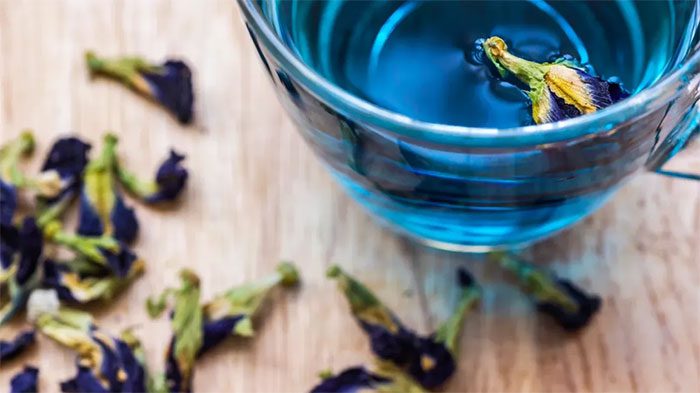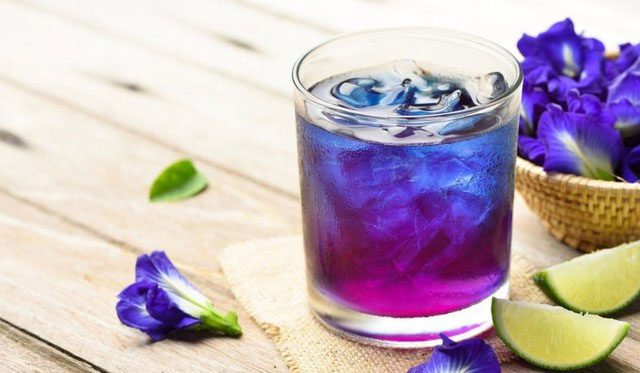This uniquely colored beverage is beneficial for cardiovascular health and brain function, effective in blood sugar control, and anti-aging.
Butterfly pea flower is a flower with striking shades of blue and violet, originating from a perennial climbing herb. This flower is widely used in Vietnam as a natural food coloring, in beverages, and in baking. According to traditional medicine, butterfly pea flowers can be used to control sweating, act as a diuretic, detoxify the body, and benefit the skin.

The blue color of this tea is due to its high anthocyanin antioxidant content.
Notably, regular consumption of butterfly pea tea can provide numerous health benefits. The blue color of this tea comes from its high anthocyanin antioxidant content, which is found in other blue and purple fruits and vegetables. This tea is caffeine-free, making it suitable for afternoon or evening consumption without the worry of insomnia; however, it is advisable not to drink it on an empty stomach.
Lower Blood Pressure and Cholesterol
Drinking butterfly pea tea has been shown to help improve blood pressure and cholesterol levels. The extract of butterfly pea flowers reduces blood pressure due to its vasodilating properties, enhances blood flow, and prevents the formation of blood clots, which are major causes of strokes. The abundant antioxidants in this tea also prevent heart disease, diabetes, and certain types of cancer.
Blood Sugar Control
Anthocyanin in butterfly pea tea helps regulate blood sugar levels by inhibiting carbohydrate-digesting enzymes, slowing the digestion process and absorption of sugar into the bloodstream. This helps lower blood sugar and insulin levels.
A small-scale study on healthy adults showed that butterfly pea extract reduced blood sugar levels 30 minutes after a meal. Diabetic patients should consult a doctor and avoid excessive consumption of this tea to prevent side effects. The recommended dosage is about 5-10 flowers, equivalent to 1-2 grams of dried flowers, or 1-2 cups of tea per day.

Butterfly pea flower is a flower with shades of blue and violet, originating from a climbing plant…
Enhancing Brain Health
Some studies indicate that regular use of butterfly pea extract can increase levels of acetylcholine in the brain. Acetylcholine is crucial for maintaining brain health, reducing age-related memory loss, and improving recall.
Improving Skin, Anti-Aging
Butterfly pea flowers are rich in antioxidants, which can slow down the aging process of the skin, boost collagen production, prevent premature aging, provide moisture, and improve skin elasticity.
Antibacterial Properties and Immune Support
Butterfly pea flowers contain many anti-inflammatory compounds that can prevent viral attacks and infections. Studies show that butterfly pea tea can aid digestion and support a healthy gut, which is closely related to enhancing immune function and protecting the digestive system from spasms, nausea, and gas.
Additionally, this beverage can support detoxification processes, eliminating harmful waste from the liver, acting as a mild laxative and natural diuretic. Butterfly pea tea also helps reduce bronchitis, colds, and coughs.

This beverage supports detoxification processes.
Precautions When Using Butterfly Pea Tea
This beverage is relatively safe, but individuals with low blood pressure or low blood sugar should avoid it to prevent dizziness and nausea. Furthermore, pregnant women, those menstruating, and individuals on anticoagulant medications should also avoid using it. Those undergoing medical treatment should consult their doctor before incorporating this beverage into their daily diet.
The appropriate temperature for brewing tea is 75 degrees Celsius, and it should be consumed immediately after brewing to retain its nutrients. In addition to consuming butterfly pea tea, those looking to control blood sugar should combine it with a healthy diet low in refined sugars and regular physical activity to achieve stable blood sugar levels.


















































